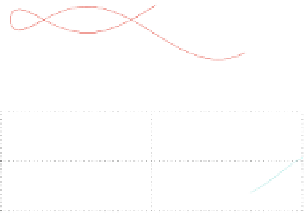Information Technology Reference
In-Depth Information
a
b
Fig. 9.3
(
a
) Particles following reference trajectory (ii), (
b
) associated control input
shows the control input along the x (top) and y axis (bottom) (continuous line:
average control, dashed line: control designed individually for the i-th particle).
9.6
Conclusions
The chapter has presented first a control method for neuron models that have the
dynamics of chaotic oscillators. The proposed chaotic control method makes use
of a linearized model of the chaotic oscillator which is obtained after transforming
the oscillators dynamic model into a linear canonical form through the application
of differential flatness theory. Moreover, flatness-based control was applied to
motion control of a multi-particle system. A set of M particles (stochastic weights)
in a 2D-plane was considered and it was assumed that the interaction between
the particles was given by forces as the ones that appear in Brownian motion.
The multi-particle formation corresponds to an ensemble of coupled harmonic
oscillators. The kinematic model of the particles comprised a drift term that was
due to the harmonic potential, a disturbance term that was due to interaction with
the rest of the particles and a term that stands for the control input. Next, by applying
flatness-based control it was shown that the mean of the multi-particle formation can
follow the reference trajectory with infinite accuracy, while each individual particle
can be steered along the desirable trajectory within satisfactory accuracy ranges.







































































































